#indian marble statues
Explore tagged Tumblr posts
Text
anyway. black argenti and indian (woman-presenting) idrila
(made with a picrew)
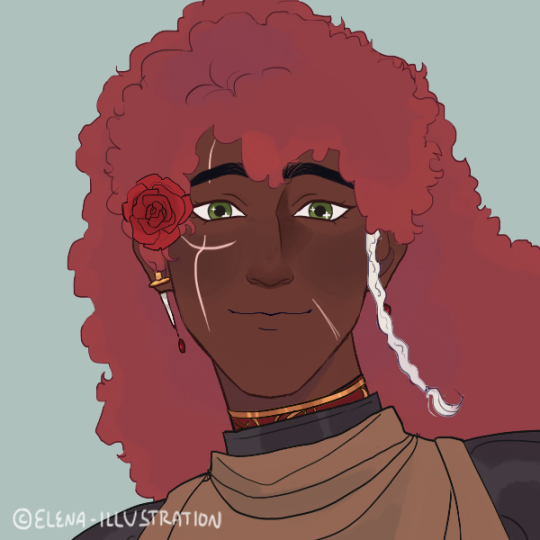
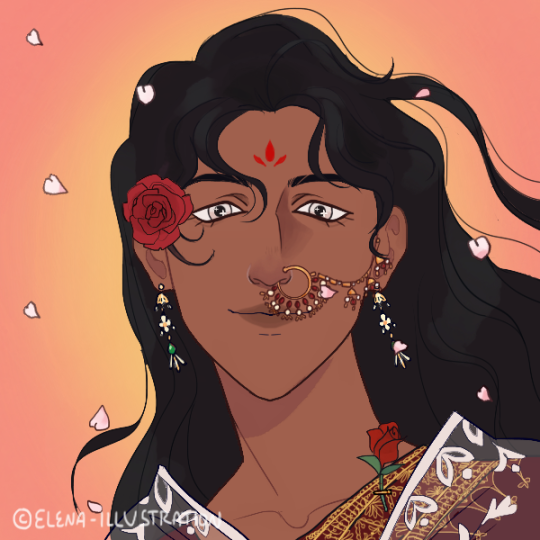
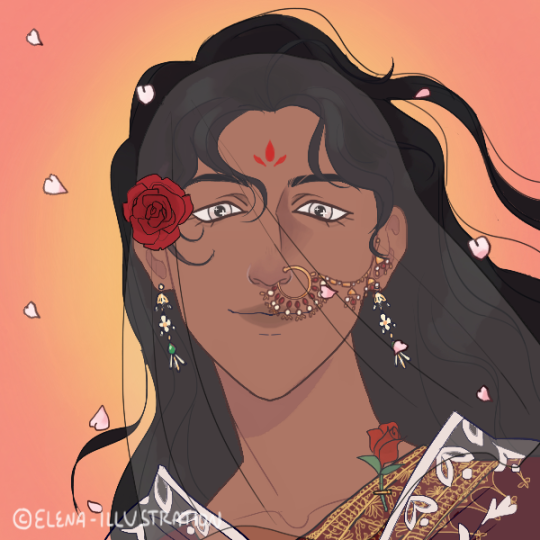
(made idrila's eyes white to be like a mirror. reflecting beauty back at you :)
#gets bored of both argenti and idrila being white/european-coded (is that the right word???)#suggesting that only white features are the epitome of beauty#also inspired by idrila's marble statue veil reminding me of (not just but though of indian) saree veils#hsr headcanons#idrila#argenti#aeon of beauty#hsr idrila#hsr argenti#argenti hsr#idrila hsr#honkai star rail#hsr
26 notes
·
View notes
Note
Could you transform me into a dumb indian bodybuilder himbo? I’d prefer to be made femme but whatever suits your fancy

You make your wish and you are suddenly transported to the land of your true ancestry. Staring back you is the dave of an Adonis and attached is the nod that look as though it was carved from marble. Before you even have time to register your new body your brown one thickens and your jaw begins to sware while a thick dark shadow creeps across your chin. Any thought you have begins to disappear in the fog that is clouding your brain as your himbo nature begins to take effect. Always wanting to please a man and be the bottom toy you need to be to please. It’s your status as gym himbo now. You’ll always wear slutty clothes that show off your body to everyone and no one will be able to resist you. Let’s hope you enjoy the life of a dim witted himbo Indian man.
194 notes
·
View notes
Text

Some neighbors of the Malarkeys were keeping a watchful eye on “the little troublemaker.” But Michael Noland, the bewhiskered maritime pilot who lived next door, found him harmless enough; he believed Donnie just had a “sense of adventure.” Flask at his side, Noland would sit on his front porch with the boy and regale him with stories of guiding ships in from the Pacific Ocean across the Columbia River sandbar, one of the world’s most dangerous. “Donnie, at times them waves’d be three stories high,” he would say. “See that telephone pole? Them white horses’d snap that like a toothpick.” Eyes wide, Donnie glanced at the pole. “There’s a reason,” said Noland, “they call it the ‘Graveyard of the Pacific.’ ” “Sounds scary,” said Donnie. “Why do you do that, Mr. Noland?” “It’s the adventure, lad. It’s wondering what’s behind the next wave—and the one beyond that, and on and on.”
[...] In contrast to Michael Noland, some people regarded Donnie with a touch of suspicion. The issues? Mischief in general and marbles in particular. Donnie was such a good player that the kids in the neighborhood would routinely lose most of their marbles—and their allowances—to the kid who lived on Kensington Avenue.
[...] He lived a sort of Huckleberry Finn life, particularly in the summer on the river. He loved the land, loved the water, loved the freedom that came with both. The Northwest was rich in Indian lore, and when Louie Jacobson—half Native American—took Donnie under his wing, the boy relished the lessons he learned. Jacobson taught him to shoot a yew-wood bow and arrow, to trap small animals, and to catch crawdads. People joked that Louie was half-Indian—and Donnie full-blooded. He explored the river in an old rowboat, fished for sea-run cutthroats, picked wild blackberries, and camped on the riverbanks. No schedule. No responsibilities. Nobody to answer to—least of all his father, whose insurance business capsized in the Depression and who, if not lost at sea, was beaten and battered trying to stay afloat. His father was “never the same,” Don Malarkey remembered as an adult. “Just went numb.” Books deepened Donnie’s sense of adventure; like Mr. Noland, he began wondering what was beyond the next wave. When the rains came in November, he would curl up with Roy Rockwood’s Bomba the Jungle Boy series. Inspired by Bomba’s living-off-the-land spirit, he adopted a swath of alder saplings at Fifteenth and Madison as his own private jungle. He would climb to a treetop, grab a branch, start swinging it, then use the “whip” to send him to the next tree, where he repeated the process. He could go an entire block without touching the ground. If Bomba inspired Donnie to climb up, his own imagination inspired him to jump down. In the early 1930s, when the U.S. Army was only beginning to experiment with the idea of parachuting men out of airplanes, Donnie climbed to the roof of the Malarkeys’ two-story house. He popped open a beach umbrella and eased himself to the roof’s edge. As if he were the Statue of Liberty holding her torch, he thrust the umbrella skyward. And jumped.
~ Bob Welch
#band of brothers#donald malarkey#in a way such a great childhood#cute kid#i just learned that his daughter died of breast cancer a month ago 😞#Saving My Enemy: How Two WWII Soldiers Fought Against Each Other and Later Forged a Friendship That Saved Their Lives
22 notes
·
View notes
Text


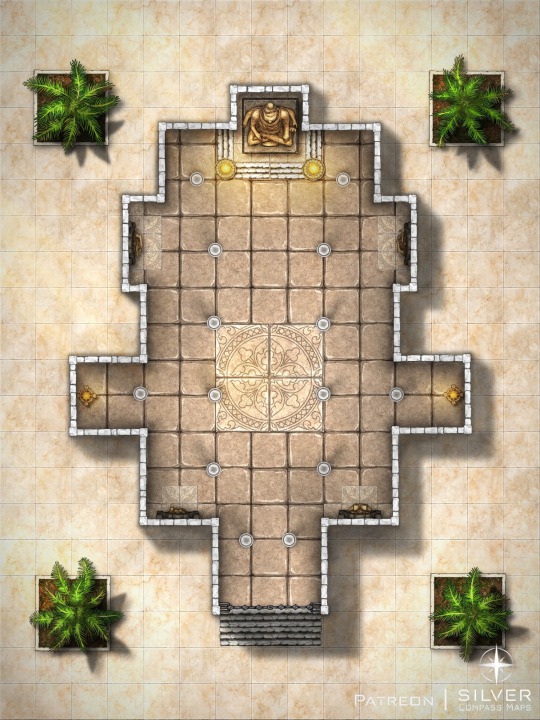
Maheshwari Indian Temple
Tall marble staircases, ornate pillars, and a golden-brass statue all welcome worshippers and travelers to the Maheshwari Mandir, which roughly translates to "Temple of the Great One."
Indian temples come in a variety of styles, but the inner structures are almost always the same. There are two main sections, an inner chamber that houses the deity called the garba griha, and an outer worshipping space called the mandala. Worship typically takes place in the form of a Puja, during which various food items are offered to the deity in a large sacrificial fire.
This map can also be used as a general fantasy temple if you wish to do so.
Download the map for free here.
This map will also be included as part in my 5e Devabhumi setting book, which will be released this year! Devabhumi is an Ancient India-inspired campaign setting, which presents an alternate world that brings the epics and stories of this rich culture to life.
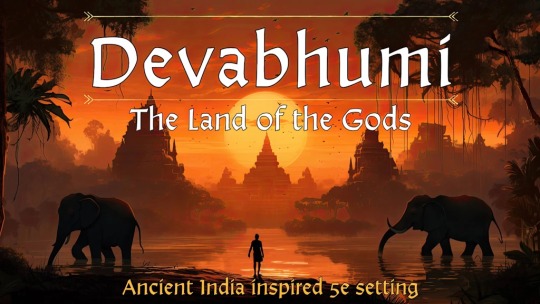
#dnd maps#battlemaps#battlemap#d&d#dnd#pathfinder#tabletop#ttrpg#cartography#dndart#fantasy map#rpgmap#5e#dnd worldbuilding#dungeon master#unearthed arcana#dnd homebrew
82 notes
·
View notes
Text
Basic about my muses in no specific order (part 1-?):

ㅤA.sclepius: ㅤ(source: Greek mythology.) Snek doctor; fucked up with the gods and found out (got struck DEAD with lighting from zeus bc he was messing around too much with the whole bringing to life dead people). Grouchy. Hates apollo. Don't come to him for a 'simple' flu, he's here for more interesting diseases.

ㅤA.shwatthama: ㅤ(source: Indian epic Mahabharata) warrior who was born with a blessing (gem on his forehead) that would grant him something close to immortality but who by a moment of grief and rage over the unjust death of his father, acts upon it and gets cursed with immortality so he's just wandering around with a wound that will never heal.

ㅤConstantine XI: ㅤ(Source: history, Europe) last Byzantine emperor / or also considered the last Roman emperor, as Byzantine emperors considered themselves as Roman emperors in direct succession from Augustus) the fall of Constantinople (the capital of the roman empire he ruled) marked the end of an era (the medieval period). He is regarded as the emperor who fought alongside his soldiers to the last breath and perished during battle. Historical based + including the chivalrous tales surrounding his figure as the emperor who fought alongside his people as well as the famous story of the 'marble emperor' in which it details how he did not die but was saved by an angel who turned him into a marble statue, waiting for a call to reconquer his old city and rebuild his fallen empire.

ㅤA.rthur P.endragon: ㅤ(source: Welsh folklore + the retelling of Arthur as king of Britain) You probably all have some semblance of the tales of king Arthur so I won't detail much about his history. Carries the weight of hope across universes. This Arthur is the image of the ideals of a knight in shining armor that you often see coming from tales in books. A man who became distant and who carries the shattered pieces of an unattainable honor, calm yet playful. Sacrificed everything for his kingdom to the point where he ignored his own humanity to become more of an instrument than a person. Currently, he is on a fight to save the world.

ㅤJ.ason: ㅤ(Source: Greek mythology, from the Argonautica) The captain of the argo and leader of the Argonauts (Jason's crew consisting of a bunch of different heroes he recruited from all over the place like Heracles, Achilles' dad, Orpheus, Atalanta, Asclepius, Medea, Castor and Pollux etc etc) basically his story is the og a.vengers (but better). Jason is the purest definition of an 'epic's hero' as well as one of the most human characters in greek mythology (alongside Odysseus who is, fun fact, his cousin!) as he possesses great leadership and ambition yet is in the same sentence, a coward with bouts of depressive/hopeless episodes who will run away first like a headless chicken as soon as the potatoes start to boil / HIS life is at risk. The definition of 'wow! this guy is actually pretty cool??' and 3 seconds after "actually, this guy sucks a.ss!"
#;about#about#/I THINK I DID THIS BEFORE BUT-#part 1 bc theres so many of them OOF-#Explaining my muses in the shittiest way possible GOGOGOGOGO#basically my whole blog is mostly: give me the top 10 worst men-#and i go; yes sir right away sir#there are some exceptions yes; but a lot of them are TERRIBLE!#i say im quitting and then these binches come back and grab me by the neck#f.ate is a curse-
10 notes
·
View notes
Text
Whenever I've contemplated the recent Canadian MAID policies, my mind has inevitably wandered to Robert W. Chambers' justly revered weird tale "The Repairer of Reputations" and the Government Lethal Chambers that are such a key thematic element therein. I am not going to imply that the Canadian health services have fallen under the sway of the Yellow Sign (although...), but I've always noticed in reading and listening to other moderns' response to the story that there's important period context that gets largely missed. This is understandable - most people haven't read nearly as many fin-de-siècle and Edwardian era 'Scientific Romances' as I have, for the good reason that most of them are really quite bad.
But without historical context, it's easy to miss exactly what the alternate future New York City that the story may or may not be set in represents. It's a whole collection of relatively common Progressive era tropes representing peoples' hopes and fears about the immediate future, arranged in an optimistic (even Utopian) key. The obsession with civic beautification, the gleaming fleets of battleships that are almost an extension of the "good architecture [that] was [everywhere] replacing bad," the optimistic hope that race problems could be settled for all times and peaceably without any then-unseemly 'mixing' (Indian scouts! an "independent negro state of Suanee"! checking of immigration!), a militarism that's as much about pomp & love of regimentation as about actual wars, the "colossal Congress of Religions" that "laid [bigotry and intolerance] in their graves" and "began to draw warring sects together", a love of orderly centralization... This is all the sort of stuff that moderate, bien-pensant Progressives and Fabians of Chambers' day would have cheered on. Even the "war with Germany," involving an unlikely occupation of the Virginia coast, is an optimistic take on the Invasion Story subgenre that was becoming common at the time (the scars it left "had been forgotten in the joy over repeated naval victories, and the subsequent ridiculous plight of General Von Gartenlaube's forces in the State of New Jersey.") It's all of a piece, an expression of boundless Columbian Exposition optimism and faith in Reason and Progress to bring forth an Earthly Paradise.
And so are the Lethal Chambers. They are reasonable, and graceful, and beautiful, solutions to the problem of hopelessness. Reasonably, why should a person not have a right "to end an existence which may have become intolerable to him, through physical suffering or mental despair"? Too, "the community will be benefited by the removal of such people from their midst." And the Chamber is beautiful, placed in a verdant park, decorated with Grecian columns and marble statues, designed to make one's exit from this world as rationally elegant as possible. It's all done discreetly, in the best possible taste.
This is why the story is given this whole setup, why it begins with what seems today to be a very disorienting bit of archeofuturistic world-building. In the context of this world of rational hopes rationally filled, not only is Castaigne's descent into madness more shockingly out of place, but it also represents an irruption into that world of something else, something old and strange and powerful. There is a reason that Wilde & Castaigne invoke the trappings of the archaic medievalism that the Progressive world sought to do away with forever, and a reason why Wilde deals (or claims to deal) in blackmail and conspiracy. All the flotsam and jetsam that, it was hoped, could be swept away like the old slums, bob inevitably to the surface.
As something of a reactionary, I'm inclined to take a political reading of this - "don't immanentize the eschaton!" as the slogan goes. But, like all really good fiction, "The Repairer of Reputations" is about something deeper than politics. I leave further interpretation as an exercise to the reader.
20 notes
·
View notes
Text

Admission to many museums in the UK are free, so once and a while we drop in to get to see local art. Here are some photos of art with themes of colonization, injustice, and issues of our time at Tate Liverpool.

This photo is of a Palestinian woman in what’s left of her home during the Sabra Camp massacre in 1982. It is by Don McCullin, a British photographer who covered the Lebanese Civil War during his visits in 1976 and 1982. Palestinian refugees fled to Lebanon after the establishment of Israel in 1948 in what was once a part of Palestine. The war in Lebanon led to massacres of Muslim neighborhoods including Palestinians in the Sabra refugee camp.
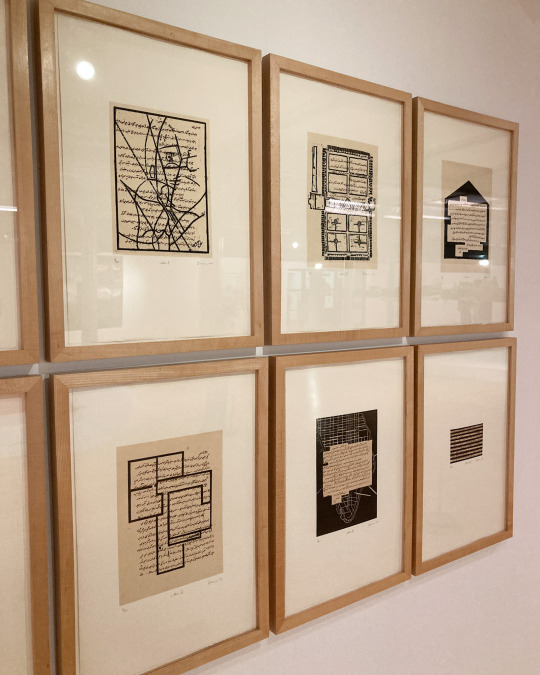
The late Zarina Hashmi was an Indian-American artist born in India, whose family was displaced by the 1947 partition of India after British colonial rule. While her sister Rani moved to Pakistan, Zarina eventually traveled the world, staying in touch with her sister everywhere she went. “Letters from Home” use these letters from Rani as a basis for the art, as they are written in Urdu and printed along with depictions of blue prints and maps of the places Zarina had lived through the years.
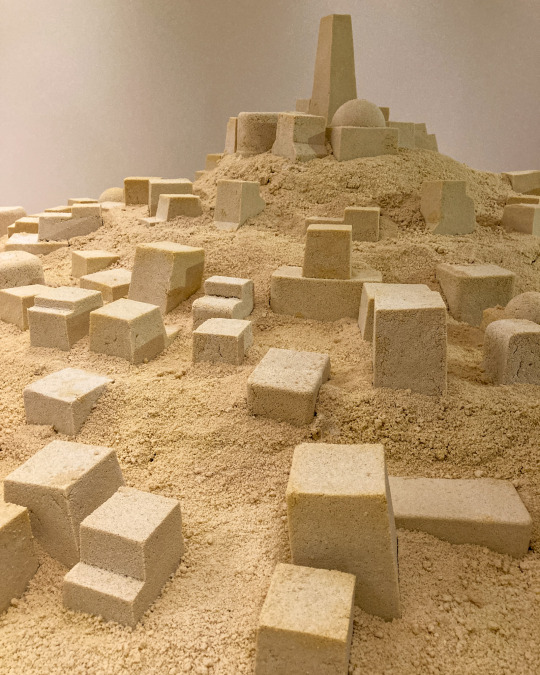
Kader Attia was born in France to Algerian parents, and later grew up in Algeria. Believe it or not, this artwork is made out of food. Specifically, couscous, a staple in Algeria as well as the rest of North Africa. Near the exhibit is a photo of Swiss-French architect Le Corbusier, who applied modernist architecture during the French colonial period in Algeria near the mid 1900s. In this artwork Attia seems to shape buildings in the modernist style, depicting the ancient hilltop city of Ghardaia in Algeria. The buildings are molded in couscous, and cracks and crumbling areas in the buildings could be seen as weathering from both the city’s old age and French colonization.
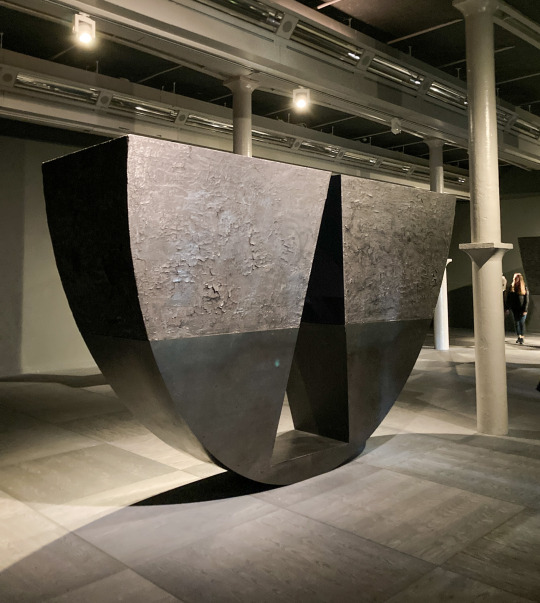
Torkwase Dyson handcrafted these huge, black structures and placed them in a large dark space on the first floor of Tate Liverpool. Dyson’s abstract works “grapple with the ways in which space is perceived, imagined and negotiated particularly by black and brown bodies.” This installation, “Liquid a Place,” definitely displays this, with these huge statues of what seam like heavy slabs of the darkest marble. They definitely convey the weight of colonization for me, and the artist description of them echoing “the curve of a ship’s hull” got me the most. Tate Liverpool sits in what was once one of Europe’s busiest ports serving the Transatlantic Slave Trade.

Lubaina Himid was one of the pioneers of the UK’s Black Art movement in the 1980s. “Carrot Piece” shows a white figure hovering a carrot over a Black woman carrying her own plentiful batch of food and items. The white figure is on a unicycle and wears light make up, conveying ridiculousness or crude entertainment, as if a clown. These are cut-out wooden paintings that are life-sized and was made for, as Himid wrote in her description, “…the moment when you slowly realise that you have learned something quite useful about yourself which proves to be a whole lot better than anything ever offered to you for free.”

Kerry James Marshall is known for his colorful paintings depicting Black people in dark shades. He counters “Western pictorial tradition” and brings forward Black figures in it. This work shows a Black figure wearing a British royal guard uniform, holding a sandwich board advertising a fish and chips restaurant named after a freedman, prominent writer, and British slavery abolitionist Olaudah Equiano. The irony of this art, is that it does not show a place in England. It is a scene in Arizona, where a “London Bridge” was made to attract American tourism.
#Tate Liverpool#Kerry James Marshall#Zarina Hashmi#Don McCullin#Lubaina Himid#Kader Attia#Torkwase Dyson
13 notes
·
View notes
Text
HANDMADE MARBLE STONE HANUMAN STATUE:
COLLECT YOURS NOW...
Hindu Mythology of Hanuman : Lord Hanuman viewed as the ideal combination of "strength, heroic initiative and assertive excellence" and "loving, emotional devotion to his personal god Rama", as Shakti and Bhakti. He symbolizes the human excellences of inner self-control, faith, and service to a cause, hidden behind the first impressions of a being who looks like a Vanara.
#hanumanstatue#indianfolkart#indianartcollectors#hindustatue#goddessstatue#stonedurgastatue#indianhomedecor#hinduart#indianart#indiansculpture#vintageart#indianhandicraft#susunia#bengaligift#thankgivinggiftforinlaws#hinduculture#hindudeity#hindugodsandgoddesses#indianartists#indianartisans#indiancontemporaryart#indianapolisart#indiantraditionalart#indiantribalart#artindian#indianwallart#indianfloorart#artistindian#hindumythology
3 notes
·
View notes
Text
it's the same with buildings
I love old architecture and broadly hate the modern stuff (well, mostly I hate shoddy glass towers put up quickly to make venture capitalists money; actual Artistic buildings in modern styles aren't my thing, but I can respect them more). I don't think Eurpoean architecture is The Objective Best like some marble statue profile pictures do, but I freely admit that 17th-19th century mainstream European buildings are my personal happy place
I also work in historical site museums
and there is. no goddamn support for anyone who wants to go into preserving or recreating those architectural styles
say you want to learn carpentry- master craftsman-style carpentry with flourishes and decorations. okay, who's paying for you to live while you go through your trade school or apprenticeship? IS there even a trade school that teaches that where you live? there are precious few left out there. and if you DO manage to complete a program in that field, where are you going to work? you could go into historical preservation/restoration if there's a call for that where you are, or you're willing/able to move someplace where there is. but building companies constructing new, everyday structures sure as hell aren't going to pay for it. because the billionaires who own them just want to cut costs as much as possible so they can maximize their profits. and anyway, ornamentation and Style are risky. they're not safe, bland designs that can appeal to the maximum number of people and not risk alienating or challenging anyone
you can apply that to anything that used to be a common trade associated with constructing beautiful buildings: artistic stonemasonry and sculpture, stained-glass windows, laying decorative tile, making ornamental plaster elements...there's just no support for any of it. and that breaks my heart, honestly
especially because, with the fact that European art isn't held up as the universal ideal (as much) anymore, you could do so many things with it! imagine a library with a Mexican-inspired stained glass window, or a post office modeled on an Ethiopian fortress. imagine entire wooden banisters in public buildings with Indian brass and mother-of-pearl inlay designs
people want it. other people want to do it! but there's just...no tenable way to make a living like that anymore, in many countries
you want grand neoclassical or Italianate or Renaissance revival buildings again? stand up for workers' rights and free higher education, and make the fucking developers take a pay cut

#spoiler nobody is going to do that unfortunately#I know two (2) young apprentice horologists- mechanical clock experts#people LOVE mechanical clocks. my pocket watch delights museum guests if they notice and ask about it#but because the Powers That Be have decided they're not worthwhile the system has slowly made it impossible#to learn to work with them much less create new ones
120K notes
·
View notes
Text
Why a Marble Ganesh Murti is the Perfect Addition to Modern Interiors
In today’s fast-paced world, modern homes are evolving beyond just minimalistic aesthetics. There’s a growing desire to integrate peace, culture, and spiritual energy into interior spaces. One timeless and elegant way to achieve this is by adding a Marble Ganesh Murti to your home decor. Combining divine presence with sophisticated artistry, a Ganesh Marble Statue perfectly blends tradition and contemporary style.

Symbolism That Enriches Your Space
Lord Ganesha, the remover of obstacles and the harbinger of wisdom, is deeply revered in Indian culture. Placing a Ganesh Marble Statue for Home isn’t just about decor—it invites blessings, positivity, and balance into your living space. Whether placed at the entrance, in the pooja room, or on a well-lit shelf, a Marble Ganesh Murti brings an aura of calm and spiritual connection.
Aesthetic Elegance in Modern Interiors
Modern interiors often feature clean lines, neutral palettes, and functional design. A finely carved Ganesh Marble Statue adds a focal point with its white purity and intricate craftsmanship. It blends beautifully with wooden textures, glass elements, or metallic accents, enhancing the overall look without overwhelming it.
Designers and homeowners alike are increasingly choosing marble idols for their subtle yet striking presence. Unlike resin or metal idols, marble has a timeless quality that resonates with luxury and serenity.
Handcrafted Artistry from Skilled Marble Murti Manufacturers
Each Marble Ganesh Murti is a masterpiece, especially when sourced from renowned Marble Murti Manufacturer. These artisans invest hours—sometimes days—into chiseling, detailing, and polishing the statue to perfection. The result is not just a sculpture but a sacred expression of devotion and fine craftsmanship.
Rajasthan, especially Jaipur, is known for being home to some of the best in India. Whether you’re looking for a traditional seated Ganesha, a dancing pose, or a minimalist design, these experts can customize it to suit your decor vision.
Choosing the Right Marble Statue Manufacturer
If you're considering adding a Ganesh Marble Statue for Home, choosing the right Marble Statue Manufacturer is crucial. Look for experienced artisans who offer:
Authentic, high-quality marble (Makrana or Vietnam White)
Customization options in size, posture, and finish
Reliable packaging and safe delivery
Verified testimonials and a trusted portfolio
Working directly with a reputed Marble Murti Manufacturer ensures that you receive a statue that is not only spiritually valuable but also artistically inspiring.
Perfect Placement Ideas
Here are a few suggestions for placing your Marble Ganesh Murti in modern homes:
Living Room Corner: Add a spotlight or backdrop panel to highlight the idol.
Entryway Console: A small idol near the entrance symbolizes protection and welcoming energy.
Meditation Room: Ideal for mindfulness and spiritual connection.
Bookshelf Niche: Combine sacred energy with intellectual pursuits for a balanced ambiance.
Conclusion
A Marble Ganesh Murti is more than a decorative element—it's a timeless blend of spirituality, craftsmanship, and elegance that fits perfectly within the framework of modern interiors. Whether you're renovating, designing a new home, or simply looking to invite divine energy, a Ganesh Marble Statue is a beautiful and meaningful addition.
For those looking to invest in a statue that truly stands out, explore options from trusted Marble God Statue Manufacturers and Marble Statue Manufacturer who understand both the art and the essence behind every murti.
Also Read : Decorating Your Home Mandir for Navratri with Marble Durga Idol
#ganesh marble statue for home#marble ganesh murti#marble murti maufacturer#marble statue manufacturer
0 notes
Text
Lord Ram to Be Honoured as King in Upcoming Ayodhya Ceremony
A year after the grand ceremony to welcome Ram Lalla at the Ram Temple in Ayodhya, another important event is on the way. This time, the temple will celebrate Lord Ram as a king, with the installation of Ram Durbar - a royal court scene featuring Lord Ram, Sita, Lakshman, and Hanuman - on the temple’s first floor next month.
This ceremony will be smaller than the one held on January 22, 2024, which saw over 8,000 people in attendance, including Prime Minister Narendra Modi. Still, it marks a major step in the temple’s journey, which began in 2020 after a Supreme Court decision cleared the way for its construction.
Temple Nears Completion
Nripendra Misra, who leads the temple construction team, said the main work on the temple will be finished by April 15. Around 20,000 cubic feet of stone still needs to be placed, and all the statues, both inside and outside the temple walls, should be installed by the end of April.
The temple is being built in a traditional Indian style. It is 380 feet long, 250 feet wide, and 161 feet tall. It stands on 392 carved stone pillars and has 44 doors. Around 20 acres of land surrounding the temple are being developed with gardens and natural features.
Ram Durbar and New Installations
The new marble statues for the Ram Durbar are being carved in Jaipur by a team of 20 artists led by sculptor Prashant Pandey. These statues will present Lord Ram in his royal form. They will join the already installed 51-inch idol of Ram Lalla (Lord Ram as a child), created by Karnataka sculptor Arun Yogiraj.
A statue of Saint Tulsidas, the poet who wrote Ramcharitmanas, a popular version of the Ramayana, is also being added to the complex.
Ramkatha Museum Set to Open Nearby
An International Ramkatha Museum is also being built about 4 km from the temple. It will offer an interactive experience, including a hologram of Lord Ram, a walk-through journey of the Ramayana, and a display of the 200-year-long Ram Temple movement. Artefacts found during excavations will also be displayed for public viewing.
A New Chapter for Ayodhya
Ayodhya is preparing once again for a moment of deep spiritual and cultural significance, honoring Lord Ram not just as a child but as a divine ruler. For latest news India in Hindi, subscribe to our newsletter!
#werindia#leading india news source#top news stories#top news headlines#national news#top news of the day#latest national news
0 notes
Text
Discover how a beautifully crafted Radha Krishna Marble Statue enhances positive energy, love, and harmony in your home. Learn the Vastu placement tips and spiritual significance of Radha Krishna idols, and why choosing skilled Marble God Statue Manufacturers and Marble Murti Manufacturers matters for sacred spaces.
0 notes
Text
Udaipur Travel Guide: Lakes, Palaces & Hidden Gems

Udaipur—often referred to as the “City of Lakes”—is one of India’s most romantic and picturesque destinations. Nestled amidst the ancient Aravalli hills in Rajasthan, this city is a living canvas of shimmering lakes, royal palaces, historic temples, and charming alleyways. Udaipur is not just a city; it's an experience that immerses you in regal beauty, cultural vibrancy, and timeless charm. In this complete travel guide, we’ll explore Udaipur’s iconic lakes, palatial heritage, and some hidden gems that even seasoned travelers might miss.
Arrival & Getting Around
Udaipur is well-connected by air, rail, and road. The Maharana Pratap Airport is just 22 km from the city and connects to major Indian cities like Delhi, Mumbai, and Jaipur. Udaipur Railway Station is centrally located, with trains running to and from major destinations.
Once you're in the city, the best way to explore is a mix of auto-rickshaws, taxis, and on foot. The old city is especially walkable, with scenic ghats, bustling markets, and photogenic havelis at every corner.
Lake Pichola: The Heart of Udaipur
No visit to Udaipur is complete without a boat ride on Lake Pichola, the city's crown jewel. Surrounded by palaces, temples, and ghats, the lake is a tranquil retreat that offers breathtaking views of the city skyline, especially during sunrise and sunset.
Jag Mandir: This island palace was a refuge for Mughal Prince Khurram (later Emperor Shah Jahan). It's open to visitors and offers stunning architecture and peaceful gardens.
Taj Lake Palace: Once a royal summer retreat, this marble marvel now functions as a luxurious heritage hotel. Though access is restricted to guests, a boat ride offers mesmerizing views.
Pro Tip: Take a sunset boat cruise that departs from the City Palace jetty for the most cinematic experience.
City Palace Complex: Udaipur’s Regal Soul
Perched on the eastern bank of Lake Pichola, the City Palace is a vast complex that seamlessly blends Mughal and Rajput architectural styles. Built over 400 years by successive rulers, it features balconies with lake views, marble courtyards, and lavish interiors.
Mor Chowk (Peacock Courtyard) dazzles with its intricate glass mosaic work.
Zenana Mahal and Sheesh Mahal showcase royal lifestyle and artistry.
City Palace Museum houses ancient weapons, royal attire, and artifacts from the Mewar dynasty.
Tip: Arrive early to avoid crowds and hire a guide or audio tour for deeper insights into Mewar’s royal legacy.
Jagdish Temple: Spiritual Centerpiece
Just a short walk from the City Palace, Jagdish Temple stands tall as a 17th-century masterpiece dedicated to Lord Vishnu. With its intricately carved pillars, elephant sculptures, and towering spire, the temple is not just a place of worship but also a celebration of Indo-Aryan architecture.
Don’t miss the evening aarti, where locals gather for soulful chanting and rituals.
Fateh Sagar Lake: Local Vibes & Leisure
While Lake Pichola attracts most tourists, Fateh Sagar Lake offers a more local experience. Surrounded by hills, it’s a favorite evening hangout for residents. You can rent paddleboats, stroll along the promenade, or sip chai while watching the sunset.
Nehru Park, located on an island in the lake, is accessible via boat and perfect for families.
Nearby, Moti Magri (Pearl Hill) hosts a bronze statue of Maharana Pratap and provides panoramic views of the lake and city.
Hidden Gem 1: Ahar Cenotaphs
A short ride from the city center lies Ahar, home to the royal cenotaphs of the Maharanas of Mewar. Over 250 stone chhatris (cenotaphs) mark the cremation sites of Udaipur’s kings. This peaceful, offbeat site features stunning 15th-century architecture and rarely sees crowds, making it ideal for photographers and history lovers.
Hidden Gem 2: Sajjangarh Monsoon Palace
Built by Maharana Sajjan Singh in the 19th century, the Monsoon Palace sits atop Bansdara Hill and overlooks Lake Pichola. Originally intended to be an astronomical center, the palace today is known for its panoramic views of Udaipur’s lakes and surrounding countryside.
Go during late afternoon to catch the golden hour light bathing the city below. Bonus: It’s inside the Sajjangarh Wildlife Sanctuary, where you might spot jackals, peacocks, and langurs.
Hidden Gem 3: Shilpgram – The Artisan’s Village
Located about 3 km west of Fateh Sagar Lake, Shilpgram is a rural arts and crafts complex that promotes traditional Rajasthani life and artistry. The village features authentic mud huts, local artisans demonstrating their work, and vibrant folk performances.
Time your visit during the Shilpgram Utsav (December) to enjoy a full-blown cultural fair with music, dance, shopping, and food.
Shopping in Udaipur: Where Art Meets Heritage
Udaipur’s bustling bazaars are treasure troves of local craftsmanship:
Hathi Pol: Known for miniature paintings, Pichwai art, and wall hangings.
Bada Bazaar: Ideal for leather jootis, silver jewelry, and colorful textiles.
Clock Tower Area: Perfect for spices, handmade diaries, and decorative brassware.
Remember to bargain politely—it's part of the fun!
Where to Eat: Royal Flavors & Rooftop Views
Udaipur’s culinary scene is as rich as its heritage. From royal thalis to lakeside cafes, the city caters to all tastes:
1559 AD: A fine-dining restaurant serving traditional Rajasthani fare with a lake view.
Ambrai: Located on the banks of Lake Pichola, ideal for romantic dinners.
Jagat Niwas Palace Restaurant: Offers sunset views and delicious laal maas.
Cafe Edelweiss: For travelers craving for drinks Best Bar Restaurants in Udaipur.
Where to Stay: From Royal to Boutique
Udaipur offers accommodation for every budget and taste. Opt for a hotel or guesthouse with a lake-facing terrace to truly enjoy Udaipur’s charm.
Best Time to Visit
The ideal time to visit Udaipur is between October and March, when the weather is pleasant and festivals like Diwali, Mewar Festival, and Shilpgram Utsav bring the city alive with color and culture.
Avoid visiting during peak summer (April to June), as temperatures can soar above 40°C.
Conclusion: A Regal Retreat for Every Traveler
Whether you're a history enthusiast, a romantic couple, an art lover, or an offbeat explorer, Udaipur opens its arms with a blend of grandeur, serenity, and soul. From its majestic palaces and serene lakes to its secret alleyways and vibrant culture, Best Resort in Udaipur offers not just sights, but stories.
Plan your visit with curiosity and openness, and the City of Lakes will reward you with memories that sparkle like the sunlit waters of Lake Pichola.
0 notes
Text
M3M Altitude Offers 3 & 4 BHK Apartments In Bangalore

M3M Group, one of the most prestigious names in Indian real estate, proudly presents its latest residential marvel — M3M Altitude. Strategically located in Sector 65, Gurgaon, this luxurious residential project redefines opulent urban living with world-class amenities, cutting-edge design, and seamless connectivity. Offering exquisitely designed 3BHK and 4BHK apartments, M3M Altitude Sector 65 is more than just a home — it’s a lifestyle statement.
An Overview of M3M Altitude Gurgaon
Nestled in the heart of Golf Course Extension Road, M3M Altitude Sector 65 Gurgaon is designed for individuals who aspire for elegance, exclusivity, and excellence. The development combines architectural brilliance with modern luxury to create an unique living experience. The lush green surroundings, coupled with smart home features and ultra-modern facilities, make M3M Altitude one of the most sought-after addresses in Gurgaon.
M3M Altitude Sector 65 - Project Highlights
Project Name — M3M Altitude Gurgaon
Developer — M3M Group
Location — Sector 65, Golf Course Extension Road, Gurgaon
Configuration — 3 & 4 BHK Luxury Apartments
Unit Sizes — Ranging from 1800 sq. ft. to 2800+ sq. ft.
Status — Newly Launched
Possession - Expected by 2028
Price Rang — Competitive pricing with flexible payment plans
Architectural Elegance At M3M Altitude Gurgaon
The architecture of M3M Altitude Sector 65 Gurgaon is inspired by global standards. With a contemporary façade, double-height lobbies, and spacious layouts, each residence in M3M Altitude offers an elegant blend of style and substance. Designed by internationally acclaimed architects, the project emphasizes natural light, ventilation, and seamless integration with the environment.
Apartment Configurations And Features
M3M Altitude Gurgaon provides a diverse selection of 3BHK and 4BHK apartments that cater to the varying lifestyle needs of homebuyers. Here’s a breakdown of configurations.
3BHK Luxury Apartments
Size: 1800–2200 sq. ft.
Spacious living and dining area
Modular kitchen with branded fittings
Walk-in wardrobes and attached bathrooms
Private balconies with stunning views
4BHK Luxury Apartments
Size - 2500–2800+ sq. ft.
Grand entrance foyers
Extended balconies for lounge and garden seating
Master bedrooms with en-suite bathrooms
Utility and servant quarters
Each apartment in M3M Altitude Sector 65 is designed to deliver the highest levels of comfort and functionality, with Italian marble flooring, VRV air-conditioning, and smart automation systems.
Also Read Blog — Assetz Marq 3 Whitefield, Bangalore — Luxury Apartments
Premium Amenities At M3M Altitude Sector 65 Gurgaon
Residents at M3M Altitude Gurgaon are treated to a luxurious lifestyle with access to a plethora of high-end amenities:
Infinity Edge Swimming Pool
Sky Lounge and Bar
Fitness Center with Modern Equipment
Yoga and Meditation Decks
Multi-Cuisine Restaurant
Private Mini Theatre
Business Lounge and Co-working Spaces
Kids’ Play Area and Daycare Center
24/7 Security with Smart Access Control
Automated Car Parking with Valet Services
These world-class amenities ensure that residents enjoy a high-quality lifestyle without having to step outside their residential enclave.
Location Advantages Of M3M Altitude Sector 65 Gurgaon
One of the standout features of M3M Altitude Sector 65 is its prime location on Golf Course Extension Road. This well-planned sector is rapidly developing into a luxury residential and commercial hub. Here are the key location benefits:-
Great Connectivity
Direct access to Golf Course Road and Sohna Road
30 minutes from IGI Airport
Nearby to NH-8 and Dwarka Expressway
Well-connected to major corporate hubs and Cyber City
Nearby Landmarks
Rapid Metro Station (5 mins drive)
Prominent schools like DPS International and St. Xavier’s
Top hospitals such as Medanta and Artemis
Malls like M3M Urbana and South Point Mall
Upcoming metro corridor for improved access
The strategic location of M3M Altitude Gurgaon makes it a perfect blend of luxury and convenience for working professionals, business leaders, and families.
Sustainable And Smart Living At M3M Altitude Gurgaon
M3M Group has integrated green building practices and smart home technologies into M3M Altitude Sector 65 Gurgaon. The project features:-
Rainwater harvesting systems
Solar panels for common area lighting
Waste management systems
Energy-efficient lighting
Smart home automation for lighting, security, and appliances
This ensures not only a sustainable lifestyle but also lower maintenance costs and a reduced carbon footprint for residents.
Why Choose M3M Altitude Sector 65 Gurgaon?
Choosing a home in M3M Altitude Gurgaon comes with several advantages:
Reputed Developer — M3M Group is known for delivering high-quality luxury projects with timely possession.
Strategic Location — Sector 65 is one of the most premium and accessible sectors in Gurgaon.
High ROI Potential — With rapid development in the area, property prices in Sector 65 are projected to appreciate significantly.
Modern Infrastructure — Smart living features, high-end materials, and contemporary design provide long-term value.
Exclusive Community — Gated and secure township with limited units for an elite living experience.
Investment Opportunity Of M3M Altitude Gurgaon
Real estate experts predict that M3M Altitude Sector 65 Gurgaon will be a high-demand property for both end-users and investors. With the growth of IT parks, commercial spaces, and social infrastructure in the vicinity, rental yields and property appreciation are expected to remain high.
Additionally, the strategic location near major highways and office hubs ensures strong capital growth potential in the coming years. For NRIs and HNIs, M3M Altitude serves as a secure and profitable investment opportunity in India’s booming real estate market.
Finish Line — Live the High Life With M3M Altitude Gurgaon
If you’re searching for a luxurious, well-connected, and future-ready home in Gurgaon, M3M Altitude Sector 65 is your perfect destination. With its blend of architectural brilliance, modern amenities, and sustainable living, M3M Altitude promises an extraordinary lifestyle in the heart of the Millennium City.
Whether you are a homebuyer looking for your dream residence or an investor seeking solid returns, M3M Altitude Sector 65 Gurgaon is the ideal opportunity to embrace next-level living.
M3M Altitude Gurgaon — Live High, Live Luxuriously
From sky lounges to infinity pools, from smart automation to green living, M3M Altitude represents a new era in residential excellence. Secure your place in the most awaited launch in Gurgaon and step into a world where elegance meets innovation.
Free Classified Ads Website — Click Now
#M3M Altitude#M3M Altitude Gurgaon#M3M Altitude Sector 65#M3M Altitude Sector 65 Gurgaon#4 BHK apartments in M3M Altitude#3 BHK apartments in M3M Altitude#M3M Altitude Floor Plan#M3M Altitude Price List#M3M Altitude Dwarka Expressway#Assetz Marq 3#Assetz Marq 3 Sarjapur Road Bangalore East#Assetz Marq 3 Whitefield Bangalore East#Assetz Marq 3 Sarjapur Road#Assetz Marq 3 Sarjapur Road by Assetz#Assetz Marq 3 Sarjapur Road Project overview#Assetz Marq 3 Sarjapur Road Residential Property#Assetz Marq 3 Sarjapur Road Residential Projects#Assetz Marq 3 Bangalore East#1 BHK Apartments Assetz Marq 3#2 BHK Apartments Assetz Marq 3#3 BHK Apartments Assetz Marq 3#Godrej Meridien#Godrej Meridien Sector 106#Godrej Meridien Gurugram#4 BHK Apartments in Godrej Meridien#4BHK Apartments in Godrej Meridien#2BHK Apartments in Godrej Meridien#1BHK Flat in Godrej Meridien#2BHK Flat in Godrej Meridien#3BHK Flat in Godrej Meridien
0 notes
Text
Aaradhana CNC Stone Routers in Uttar Pradesh – Precision Stone Cutting Solutions
n the heart of India's stone industry, Aaradhana has emerged as a trusted name among CNC Stone Router manufacturers in Uttar Pradesh. Specializing in high-precision stone carving and engraving machines, we provide advanced solutions for granite, marble, and composite stone fabrication. Our CNC Stone Routers in Uttar Pradesh are engineered for accuracy, durability, and superior performance, making them ideal for temples, monuments, countertops, and architectural designs.
Why Choose Aaradhana CNC Stone Routers?
1. Unmatched Precision & Customization
Aaradhana’s CNC Stone Routers in Uttar Pradesh use advanced servo motors and high-speed spindles to deliver intricate carvings with micron-level accuracy. Whether you need floral patterns, religious motifs, or 3D sculptures, our machines ensure flawless execution.

2. Robust Build for Heavy-Duty Performance
Designed for Uttar Pradesh’s thriving stone industry, our routers feature:
Reinforced steel frames for vibration-free operation
Diamond-tipped tools for smooth granite/marble cutting
Dust-proof systems to enhance machine longevity
3. Smart Automation & User-Friendly Controls
Aaradhana integrates IoT-enabled controls and CAD/CAM compatibility, allowing operators to upload designs seamlessly. Our CNC Stone Routers In Uttar Pradesh support:
3D/4D engraving
Batch production mode
Auto-tool changers
4. Affordable & Low-Maintenance Solutions
Compared to imported machines, Aaradhana offers cost-effective CNC Stone Routers in Uttar Pradesh with:
Local service support
Energy-efficient operations
Easy-to-replace spare parts
Applications of Aaradhana CNC Stone Routers
Temple & Monument Carving: Perfect for intricate deity statues and heritage designs.
Kitchen Countertops: Precision-cut edges for marble/granite slabs.
Architectural Cladding: Custom patterns for flooring and wall panels.
Signage & Memorials: Detailed lettering and portraits.
Serving Uttar Pradesh’s Stone Hub
Uttar Pradesh, home to Agra, Varanasi, and Lucknow, has a booming demand for stone craftsmanship. Aaradhana’s CNC Stone Routers in Uttar Pradesh empower local artisans and factories to: ✔ Boost productivity by 5X compared to manual carving ✔ Reduce material wastage with optimized cutting paths ✔ Expand business with high-quality, export-ready products
Future-Ready Stone Technology
Aaradhana is pioneering AI-assisted design libraries and cloud-based monitoring for its CNC Stone Routers in Uttar Pradesh. We aim to make stone fabrication smarter, faster, and more sustainable.
Partner with Aaradhana Today!
As a leading CNC Stone Router manufacturer in Uttar Pradesh, Aaradhana combines Indian engineering excellence with global standards. Our machines come with training, warranty, and 24/7 technical support.
0 notes
Text
Bringing Home Divine Blessings: Buy Ganesha Idols Online from The Bombay Store
In every corner of India, Lord Ganesha—the remover of obstacles, patron of arts, and symbol of wisdom—holds a special place in homes and hearts. Whether it’s for a serene corner in your living room, a sacred workspace altar, or a gift that carries blessings, a Ganesh idol for home is more than decor; it’s an invitation to grace your space with divine energy.
But in today’s fast-paced world, where do you find a piece that’s both authentic and artistically meaningful? Enter The Bombay Store, your trusted online handicraft shops that bridges tradition with convenience, letting you discover (and bring home) meticulously crafted Ganesha idols online without leaving your couch.
Why Ganesha? Because Every Home Needs a Little Magic
Ganesha isn’t just a deity; he’s a vibe. His elephant-headed form, often depicted with a modak (sweet) in hand, radiates warmth, wisdom, and a touch of whimsy. For centuries, families have welcomed his idol into their homes, believing his presence invites prosperity and peace. But let’s be honest finding the right idol matters. You want something that speaks to your soul, not mass-produced resin from a crowded market.
That’s where The Bombay Store steps in. As a pioneer in curating Indian handicrafts, they’ve turned the hunt for a Ganesh idol for home into a journey of artistry and discovery.
From Artisan Hands to Your Home: The Bombay Store’s Craftsmanship
What makes The Bombay Store a standout online handicraft shop? It’s their unwavering commitment to authenticity. Each Ganesha idol here is a labour of love, crafted by artisans whose skills have been honed over generations. Think brass idols from Tamil Nadu, polished to a golden gleam; earthy terracotta pieces from West Bengal, echoing rustic charm; or sleek marble sculptures from Rajasthan, perfect for modern interiors.
These aren’t just idols—they’re stories. Stories of hands moulding clay under the Rajasthan sun, of chisels dancing on wood in Karnataka, and of families preserving traditions in a world racing toward the generic.
And the best part? You don’t need to trek across India to find them. With a few clicks, you can explore and buy Ganesha idols online, each piece photographed in vivid detail, accompanied by tales of its origin. It’s like having a virtual artisan fair at your fingertips!
A Ganesha for Every Aesthetic (Yes, Even Yours)
Whether your home screams “boho chic” or whispers, “minimalist zen,” The Bombay Store has a Ganesha that’ll fit right in. Fancy a pop of colour? Opt for a hand-painted papier-mâché idol from Kashmir, bursting with floral motifs. Lean into luxury? A bronze statue with intricate carvings of lotus and peacocks might be your match. For the eco-conscious, there are sustainable options too—think recycled wood or organic dyes.
Size anxiety? Don’t sweat it. From palm-sized idols for cozy shelves to majestic centrepieces for entryways, there’s a Ganesh idol for home spaces big and small. Pro tip: Pair a brass Ganesha with indoor plants for a serene, Instagram-worthy nook.
Why Go Online? Convenience Meets Conscious Shopping
We get it—life’s busy. Between work deadlines and Mumbai’s infamous traffic, visiting physical stores isn’t always feasible. But skipping quality isn’t an option, especially for something as meaningful as a Ganesha idol. That’s why The Bombay Store’s shift to becoming a beloved online handicraft shop is a game-changer. Their website is a breeze to navigate filter by material, size, or region, read artisan profiles, and checkout securely. Plus, doorstep delivery means no crowded markets or parking woes.
But here’s the real win: When you buy Ganesha idols online from them, you’re not just getting a decor piece. You’re supporting rural artisans, preserving ancient crafts, and investing in sustainability. Most idols are made with natural, biodegradable materials, because why should spirituality come at Earth’s cost?
Conclusion
In today’s digital era, where screens often overshadow stories, The Bombay Store stands as a breath of fresh air—a soulful online handicraft shop that refuses to let tradition fade into the background. Choosing to buy Ganesha idols online here isn’t just a transaction; it’s a ripple effect. Every purchase breathes life into ancient crafts, empowers artisans in far-flung villages, and wraps your home in blessings that carry the weight of centuries.
Gone are the days when spiritual decor meant compromising on style or ethics. With their curated collection, The Bombay Store proves that divinity can be both timeless and trendy. Whether you’re drawn to the rustic charm of terracotta or the opulence of brass, your Ganesh idol for home becomes a conversation starter—a fusion of faith, art, and mindful living.
So, why settle for mass-produced when you can own a piece of India’s soul? Dive into their Ganesha idols online collection today, and let your space radiate not just beauty, but purpose. After all, the best blessings are those that give back—to the Earth, to its people, and to the stories that make us who we are.
PS: Your perfect Ganesha isn’t just a click away—it’s a legacy waiting to unfold.
0 notes